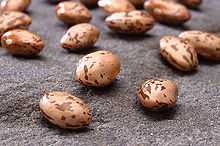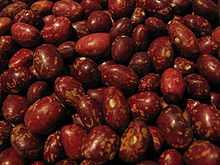Pinto bean

The pinto bean is a variety of the common bean (Phaseolus vulgaris). It is the most popular bean in the United States[1] and northwestern Mexico,[2] and is most often eaten whole in broth or mashed and refried. Either whole or mashed, it is a common filling for burritos. The young pods may also be harvested and cooked as green pinto beans.
In Spanish, they are called frijol pinto, literally "speckled bean", and in South America it is known as the poroto frutilla, literally "strawberry bean". In Portuguese, they are called feijão carioca in Brazil (literally "carioca bean") and feijão catarino in Portugal. It is named for its mottled skin (compare pinto horse), hence it is a type of mottled bean.
This is the bean most commonly used for refried beans (fresh or canned) and in many dishes. Rice and pinto beans served with cornbread or corn tortillas are often a staple meal where meat is unavailable; the amino acids in this combination make it a complete protein source. This variety is often used in chili con carne, although the kidney beans, black beans, and many others may also be used in other locales (see below).
Pinto beans are commonly eaten beans in Brazilian cuisine (legumes, mainly common bean, are a staple food everywhere in the country, cultivated since 3000 BCE, along with starch-rich foods, such as rice, manioc, pasta, and other wheat-based products, polenta and other corn-based products, potatoes and yams).
In the Southern United States, pinto beans were once a staple of the people, especially during the winter months. Some churches in rural areas still sponsor "pinto bean suppers" for social gatherings and fund raisers.

The alubia pinta alavesa, or the "Alavese pinto bean", a red variety of the pinto bean, originated in Añana,[3] a town and municipality located in the province of Álava, in the Basque Country of northern Spain. In October, the Feria de la alubia pinta alavesa (Alavese pinto bean fair) is celebrated in Pobes.[4]
Pinto bean varieties include:
- 'Burke'
- 'Othello'
- 'Maverick'
- 'Sierra'
Studies have indicated pinto beans can lower both good and bad cholesterol levels.[5][6]
Pinto beans have also been shown to contain the phytoestrogen coumestrol, which has a variety of possible health effects. [7]
References
- ↑ "Maize 2003 CGC Meeting". Ars-grin.gov. Retrieved 2012-01-14.
- ↑
- ↑ Recetas para acordarse de sabores perdidos: "Añana. Es el origen de la alubia pinta alavesa y, como tal, esta legumbre pesa en su cocina. Ya sea en cocido, crema o sopa. El queso Idiazábal o el conejo son otros de sus manjares." (Spanish)
- ↑ Algunas de las ferias tradicionales en Euskadi: "La Feria de la alubia pinta alavesa, que se celebra en octubre en la localidad de Pobes." (Spanish)
- ↑ "Pinto bean consumption changes SCFA profiles in fecal fermentations, bacterial populations of the lower bowel, and lipid profiles in blood of humans". J. Nutr. 137 (11): 2391–8. November 2007. PMID 17951475.
- ↑ "Pinto Bean Consumption Reduces Biomarkers for Heart Disease Risk". Jacn.org. Retrieved 2012-01-14.
- ↑ Bhagwat, Seema; Haytowitz, David; Holden, Joanne (September 2008). USDA Database for the Isoflavone Content of Selected Foods (PDF) (Release 2.0 ed.). Beltsville, Maryland: U.S. Department of Agriculture. Retrieved 10 March 2015.